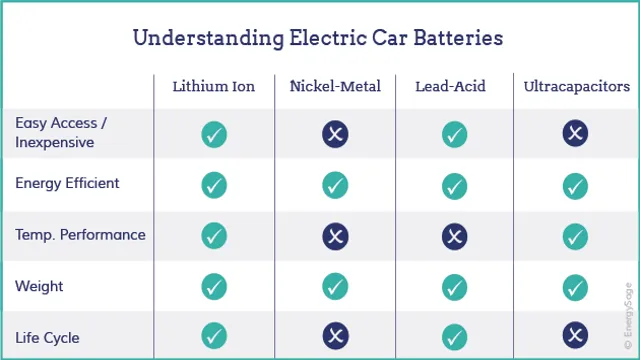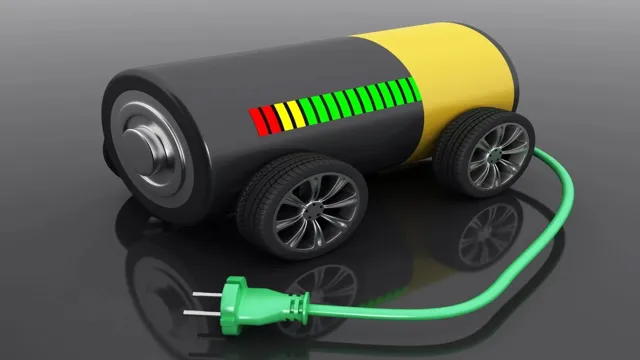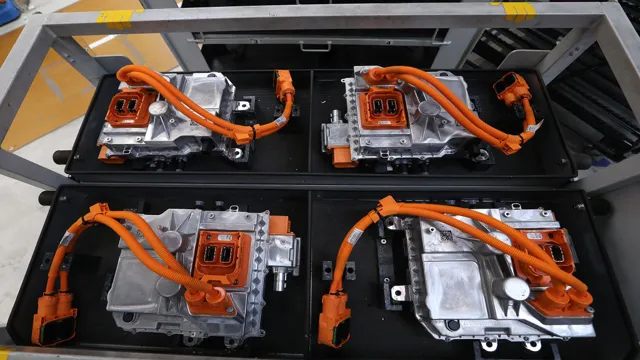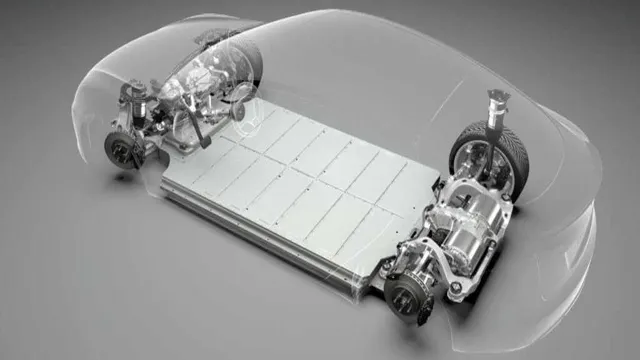Exploring the Different Types and Sizes of Electric Car Batteries: A Comprehensive Guide
Electric cars have revolutionized the way we travel, and it’s not just because they’re more eco-friendly than gas-guzzling counterparts. One of the most significant components of electric cars is their batteries, which are responsible for powering their electric motors. But, how much do you really know about electric car batteries? Electric car batteries are much bigger and more complex than the batteries that power our smartphones and laptops.
They are also made up of countless cells that work together to store and deliver energy to the vehicle’s motor. Understanding how these batteries work, how long they last, and how to properly charge them is essential for electric car owners and enthusiasts alike. In this blog post, we will take a deep dive into electric car batteries, covering everything from their basic components to more advanced topics like thermal management, charging infrastructure, and recycling.
We’ll also discuss some of the advantages and disadvantages of different types of electric car batteries and explore the future of battery technology. So, whether you’re a seasoned EV driver or just curious about the inner workings of electric cars, this blog post is for you. Get ready to discover the fascinating world of electric car batteries and all that they have to offer.
Types of Electric Car Batteries
If you’re in the market for an electric vehicle, one of the most important aspects to consider is the type of battery it uses. There are several types of electric car batteries on the market today, each with its own set of advantages and disadvantages. The most common type of electric car battery is the Lithium-ion battery, which is widely used due to its high energy density, long lifespan, and ability to recharge quickly.
Another type of electric car battery is the Lead-acid battery, which is less expensive but heavier and has a shorter lifespan. Meanwhile, Nickel-metal hydride batteries have a longer lifespan than Lithium-ion batteries and are more environmentally friendly, but they are also heavier and have lower energy density. Other types of electric car batteries include Zinc-air batteries, Lithium-sulfur batteries, and Solid-state batteries, each with their own unique set of benefits and drawbacks.
When selecting an electric car battery, it’s important to consider factors such as price, energy density, lifespan, and environmental impact. Ultimately, the right choice of battery will depend on your personal needs and priorities as an electric vehicle owner.
Lithium-Ion Batteries
When it comes to electric car batteries, there are a few different types to consider. One of the most popular and widely-used options is the Lithium-Ion battery. These batteries are preferred for their high energy density, which means they can store a lot of energy in a small space.
That’s why you’ll often see Lithium-Ion batteries used in portable electronic devices like smartphones and laptops. Despite their small size, they can pack a big punch in terms of power and longevity. Lithium-Ion batteries are also relatively lightweight, which is an added bonus for electric cars, as every extra pound can impact overall efficiency.
While they can be more expensive than other battery types, their durability and reliable performance make them a popular choice in the electric car industry. So if you’re considering an electric car, it’s likely that you’ll come across Lithium-Ion batteries as an option.

Nickel-Metal Hydride Batteries
When it comes to electric car batteries, there are a variety of different types available on the market today. One of these types is the nickel-metal hydride battery. These batteries have been around for quite some time and were one of the earliest types of rechargeable batteries used in electric cars.
They are known for their energy density, which allows them to store a large amount of energy in a relatively small package. This makes them a popular choice for hybrid vehicles, as they can provide a significant boost in fuel efficiency with their ability to store and release energy quickly. However, like all batteries, they do have their drawbacks.
For one, they tend to be heavier than other types of rechargeable batteries, which can be a concern for electric cars that need to be as light as possible to maximize their range. Additionally, they are not as efficient at storing energy as some newer battery technologies, which can limit their effectiveness in certain situations. Despite these drawbacks, nickel-metal hydride batteries remain a viable option for many electric car owners and are likely to continue to be used in hybrid vehicles for the foreseeable future.
Lead-Acid Batteries
Lead-acid batteries have been used in electric cars since their inception, and they continue to have a role in the industry today. These types of batteries are relatively inexpensive and can withstand many discharge and charge cycles, making them a popular choice for electric vehicles. However, they do have some drawbacks.
For one, they are heavier than other types of batteries, which can affect an electric car’s range. Additionally, they are not as efficient as other batteries, meaning they will require more charging time. Despite these disadvantages, lead-acid batteries remain a viable option for electric cars and are commonly used in hybrid vehicles, where they work in conjunction with other batteries to provide power.
When it comes to electric car batteries, there are many options to consider, and each comes with its own set of pros and cons. It’s essential to weigh these factors when choosing a battery to ensure it meets your needs and fits your budget.
Electric Car Battery Sizes
Electric car batteries come in an array of sizes and types. The size of a battery can have a significant impact on an electric car’s performance, driving range, and overall cost. The most common electric car battery types are Lithium-ion and Nickel-metal hydride.
Lithium-ion batteries are the most popular due to their high energy density and long lifespan. They are also lighter and smaller than nickel-metal hydride batteries, making them ideal for use in electric vehicles. The size of the battery varies according to the car’s make and model, ranging from 30kWh for compact cars to over 100kWh for larger SUVs.
The larger the battery, the greater the range and power the electric car will possess. However, the cost of larger batteries can disproportionately impact the overall cost of the car. Therefore, it is important to consider the driving range needed and budget constraints when selecting an electric car with a battery size that suits individual preferences and needs.
Capacity and Range
When it comes to electric cars, the battery is undoubtedly one of the most important components of the vehicle. The size of the battery can greatly affect the car’s capacity and range. Electric cars can have different battery sizes ranging from small batteries that deliver a low range to much larger batteries that allow the car to travel further.
One example of an electric car with a smaller battery is the Nissan Leaf, which has a 40 kWh battery that gives it a range of around 150 miles. In contrast, the Tesla Model S has a maximum battery size of 100 kWh, which provides a range of up to 402 miles. Electric car drivers need to consider their driving needs when choosing a vehicle with the right battery size.
For short commutes or city driving, a car with a smaller battery may suffice, while for long-distance travel, a car with a larger battery capacity is necessary. With constant innovation, electric car battery technology is continually advancing, leading to even better battery capacity and range in the future.
Physical Size and Shape
Electric car battery sizes can vary greatly in physical size and shape. The most common type of electric car battery is a lithium-ion battery. These batteries can come in various sizes, depending on the make and model of the car.
The physical size and shape of the battery are highly dependent on the amount of energy that needs to be stored. Smaller electric cars may have smaller batteries that are designed for a shorter range, while larger vehicles may have larger batteries that can store more energy and offer a longer range. Additionally, the shape of the battery can be different depending on the car’s design.
Some electric cars have flat battery packs that sit underneath the vehicle, while others have vertical battery packs that take up the entire trunk space. It is important to consider the physical size and shape of the battery when choosing an electric car to ensure it fits your needs and lifestyle.
Factors Affecting Battery Performance
Electric car battery types and sizes play a crucial role in determining the vehicle’s performance. A variety of factors affect the performance of a battery, including its chemistry, age, temperature, and charging method. Different electric car battery types, such as lithium-ion, nickel-metal hydride, and lead-acid batteries, have varying characteristics that determine their lifespan, energy density, and cost-effectiveness.
Larger batteries generally provide longer ranges and faster acceleration, but they also increase the weight of the vehicle and, consequently, its energy consumption. In contrast, smaller batteries are lighter and more efficient but may not be suitable for longer trips. Ultimately, the choice of battery type and size depends on the driver’s usage patterns, budget, and environmental preferences.
Temperature
Temperature Temperature is one of the main factors that can significantly affect battery performance. When operating batteries outside their recommended temperature range, their ability to store and deliver energy can be greatly reduced. Batteries that are exposed to high temperatures for prolonged periods can experience thermal runaway, a phenomenon that can cause them to lose their capacity or even catch fire.
In contrast, low temperatures can also impact battery performance by increasing its internal resistance, which can cause the battery to deliver less energy than expected. Moreover, rapid temperature changes can cause the battery to swell or contract, leading to internal damage that can reduce its capacity and lifespan. Therefore, it is crucial to store, charge, and use batteries within their recommended temperature range to ensure optimal performance and avoid safety risks.
Driving Habits
When it comes to battery life, your driving habits play a significant role in determining how long your car battery will last. There are several factors that can affect your battery’s performance, such as frequent short trips, extreme temperatures, and leaving accessories on while the engine is off. Short trips don’t allow your battery enough time to fully charge, leading to a shortened lifespan.
Extreme temperatures, both hot and cold, can also take a toll on your battery’s health. Additionally, leaving accessories like headlights or radio on while the engine is off can cause the battery to drain and decrease its overall performance. To extend your battery’s life, consider taking longer trips to allow it to fully charge, parking in shaded areas to reduce extreme temperature exposure, and always turning off accessories and lights when the engine is off.
By taking care of your battery and adjusting your driving habits, you can improve its performance and help it last longer.
Choosing the Right Electric Car Battery
When it comes to choosing the right electric car battery, there are many factors to consider, including the type and size of the battery. There are three main types of batteries used in electric cars: lead-acid, nickel-metal hydride, and lithium-ion. Of these three, lithium-ion is by far the most popular due to its high energy density and long lifespan.
In terms of size, electric car batteries can range from small and portable to large and heavy, with the most common sizes being around 60-100 kWh. Ultimately, the right electric car battery for you will depend on the range you require, the cost, and any environmental concerns you may have. It’s always wise to consult with a professional before making a decision.
Conclusion
In the world of electric vehicles, battery types and sizes are crucial factors that determine a car’s performance and range. From lithium-ion to solid-state, the options seem endlessly complex, but ultimately the choice comes down to a balance of efficiency, durability, and most importantly, affordability. Size matters too, as a larger battery may provide longer range but comes with added weight and cost.
As electric car technology continues to evolve, the key is finding the right combination of battery type and size to provide optimal power and range for the driver – and what’s more electric(ifying) than that!”
FAQs
What are the most commonly used electric car battery types?
Lithium-ion, nickel-metal hydride (NiMH), and lead-acid batteries are the most commonly used types of electric car batteries.
How do different battery sizes affect electric car performance?
Generally, larger battery sizes mean longer driving ranges and better acceleration. However, they also tend to be more expensive and heavier, which can affect the overall performance of the car.
Are there any new and innovative battery types for electric cars?
Yes, new battery types like solid-state batteries and lithium-sulfur batteries are being developed, which promise higher energy densities and faster charging times.
How can electric car owners prolong the lifespan of their car batteries?
Owners can prolong the lifespan of their electric car batteries by avoiding extreme temperatures, avoiding frequent fast charging, and keeping the battery at around 50% charge when not in use.






